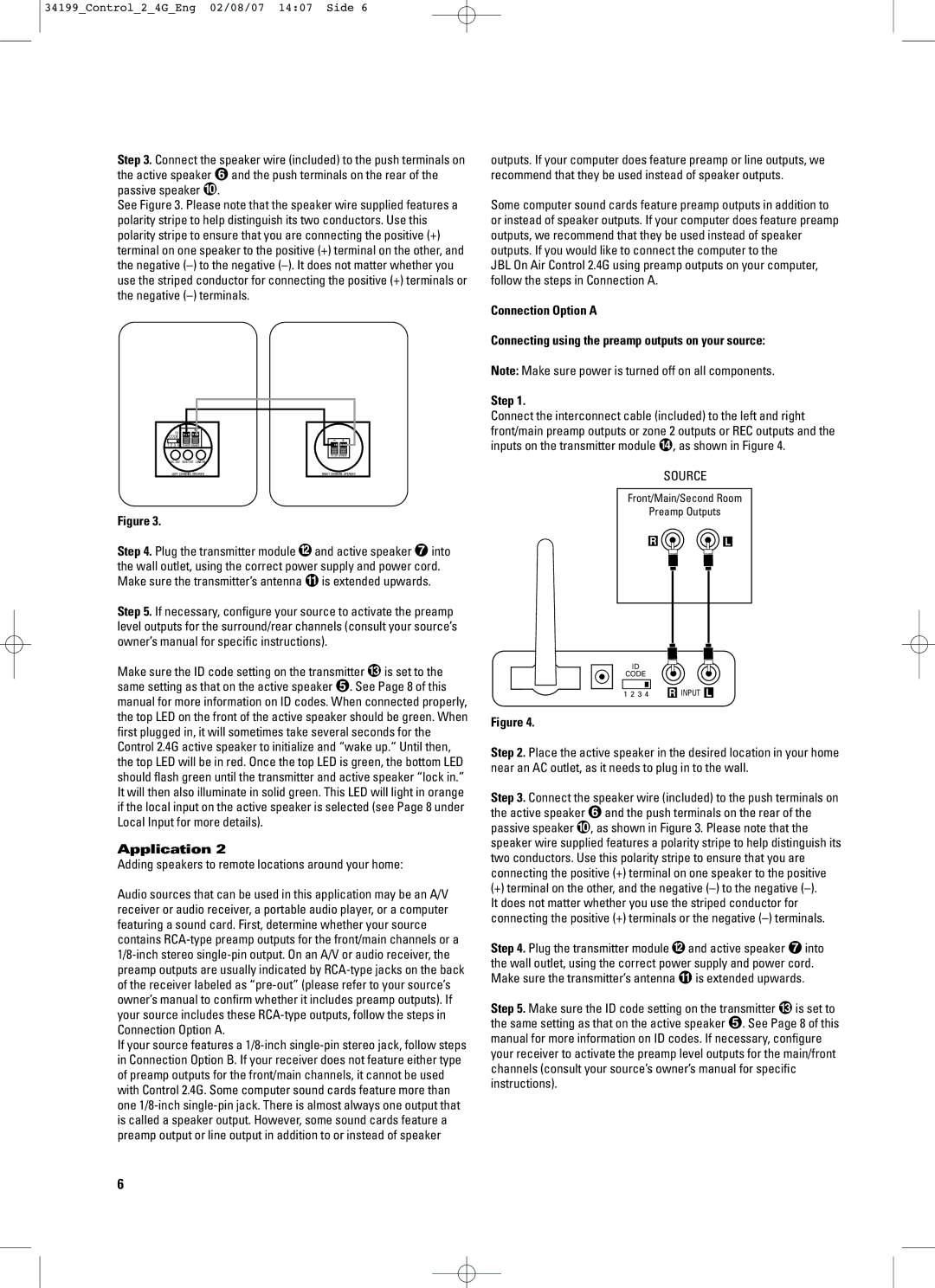Step 3. Connect the speaker wire (included) to the push terminals on the active speaker and the push terminals on the rear of the passive speaker .
See Figure 3. Please note that the speaker wire supplied features a polarity stripe to help distinguish its two conductors. Use this polarity stripe to ensure that you are connecting the positive (+) terminal on one speaker to the positive (+) terminal on the other, and the negative (–) to the negative (–). It does not matter whether you use the striped conductor for connecting the positive (+) terminals or the negative (–) terminals.
–+
ID
CODE
| – | + |
1 2 3 4 | TO RIGHT SPEAKER | |
TO LEFT SPEAKER
DC 20V SUB OUT LINE IN
LEFT CHANNEL SPEAKER | RIGHT CHANNEL SPEAKER |
Figure 3.
Step 4. Plug the transmitter module and active speaker into the wall outlet, using the correct power supply and power cord. Make sure the transmitter’s antenna is extended upwards.
Step 5. If necessary, configure your source to activate the preamp level outputs for the surround/rear channels (consult your source’s owner’s manual for specific instructions).
Make sure the ID code setting on the transmitter is set to the same setting as that on the active speaker . See Page 8 of this manual for more information on ID codes. When connected properly, the top LED on the front of the active speaker should be green. When first plugged in, it will sometimes take several seconds for the Control 2.4G active speaker to initialize and “wake up.“ Until then, the top LED will be in red. Once the top LED is green, the bottom LED should flash green until the transmitter and active speaker “lock in.” It will then also illuminate in solid green. This LED will light in orange if the local input on the active speaker is selected (see Page 8 under Local Input for more details).
Application 2
Adding speakers to remote locations around your home:
Audio sources that can be used in this application may be an A/V receiver or audio receiver, a portable audio player, or a computer featuring a sound card. First, determine whether your source contains RCA-type preamp outputs for the front/main channels or a 1/8-inch stereo single-pin output. On an A/V or audio receiver, the preamp outputs are usually indicated by RCA-type jacks on the back of the receiver labeled as “pre-out” (please refer to your source’s owner’s manual to confirm whether it includes preamp outputs). If your source includes these RCA-type outputs, follow the steps in Connection Option A.
If your source features a 1/8-inch single-pin stereo jack, follow steps in Connection Option B. If your receiver does not feature either type of preamp outputs for the front/main channels, it cannot be used with Control 2.4G. Some computer sound cards feature more than one 1/8-inch single-pin jack. There is almost always one output that is called a speaker output. However, some sound cards feature a preamp output or line output in addition to or instead of speaker
outputs. If your computer does feature preamp or line outputs, we recommend that they be used instead of speaker outputs.
Some computer sound cards feature preamp outputs in addition to or instead of speaker outputs. If your computer does feature preamp outputs, we recommend that they be used instead of speaker outputs. If you would like to connect the computer to the
JBL On Air Control 2.4G using preamp outputs on your computer, follow the steps in Connection A.
Connection Option A
Connecting using the preamp outputs on your source:
Note: Make sure power is turned off on all components.
Step 1.
Connect the interconnect cable (included) to the left and right front/main preamp outputs or zone 2 outputs or REC outputs and the inputs on the transmitter module , as shown in Figure 4.
SOURCE
Front/Main/Second Room
Preamp Outputs
R  L
L
ID
CODE
1 2 3 4 R INPUT L
Figure 4.
Step 2. Place the active speaker in the desired location in your home near an AC outlet, as it needs to plug in to the wall.
Step 3. Connect the speaker wire (included) to the push terminals on the active speaker and the push terminals on the rear of the passive speaker , as shown in Figure 3. Please note that the speaker wire supplied features a polarity stripe to help distinguish its two conductors. Use this polarity stripe to ensure that you are connecting the positive (+) terminal on one speaker to the positive
(+)terminal on the other, and the negative (–) to the negative (–). It does not matter whether you use the striped conductor for connecting the positive (+) terminals or the negative (–) terminals.
Step 4. Plug the transmitter module and active speaker into the wall outlet, using the correct power supply and power cord. Make sure the transmitter’s antenna is extended upwards.
Step 5. Make sure the ID code setting on the transmitter is set to the same setting as that on the active speaker . See Page 8 of this manual for more information on ID codes. If necessary, configure your receiver to activate the preamp level outputs for the main/front channels (consult your source’s owner’s manual for specific instructions).

